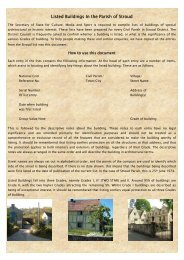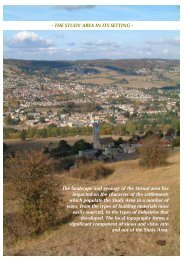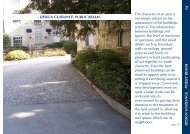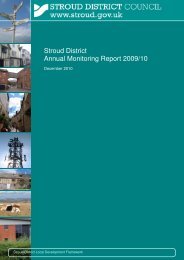CONSERVATION AREA STATEMENT - Stroud District Council
CONSERVATION AREA STATEMENT - Stroud District Council
CONSERVATION AREA STATEMENT - Stroud District Council
Create successful ePaper yourself
Turn your PDF publications into a flip-book with our unique Google optimized e-Paper software.
<strong>CONSERVATION</strong> <strong>AREA</strong> <strong>STATEMENT</strong> - Conservation Area No7: FRAMPTON ON SEVERN<br />
Frampton Court has long been at the heart of the village, and can just be glimpsed over its impressive walls. It is set<br />
apart from The Green, but is still an integral part of its character. The present Frampton Court stands on the site of a<br />
brick house built in 1651 by John Clifford. In 1731, Richard Clutterbuck began a complete rebuilding, this time in<br />
extremely fashionable (and expensive) Bath Stone.<br />
The new house is thought to have been designed by John Strahan, a notable architect from Bristol. The flamboyant<br />
Baroque- influenced front elevation features a grand stairway leading to the front door with its heavy Gibbs surround.<br />
The central pediment above, supported on square Ionic pilasters, displays the combined coats of arms of the Clutterbuck<br />
and Clifford families. The more austere influence of the Palladian movement can be seen in the garden elevation.<br />
One of Frampton’s greatest joys is the ‘delicious Gothick’ Orangery at Frampton Court. This stone wedding cake of<br />
a building was constructed in the late 1740s, also at the behest of Clutterbuck, ostensibly as a garden house, but<br />
additionally as a delightful termination to the view down his highly fashionable new Dutch canal. Happily, being sited<br />
only just behind the walls of the park, it can delight everyone else as well.<br />
Many of the other, mostly 18th century, buildings around The Green, have a smaller scaled grandeur. Some feature<br />
quirky details that set them apart from the ordinary. The early 18th century Russell House, for example, has a heavily<br />
elaborate 19th century porch; The Red House, which is otherwise handsome but unremarkable, is brought to the<br />
attention by the large wooden dovecote attached to its front elevation.<br />
Other simpler buildings, such as the Bell Inn, Frampton Lodge and the Post Office and stores, are among the most<br />
imposing presences on The Green. These are archetypal Georgian buildings, simply built of brick in the polite<br />
architectural style that spread country-wide.<br />
<strong>Stroud</strong> <strong>District</strong> <strong>Council</strong><br />
37

















